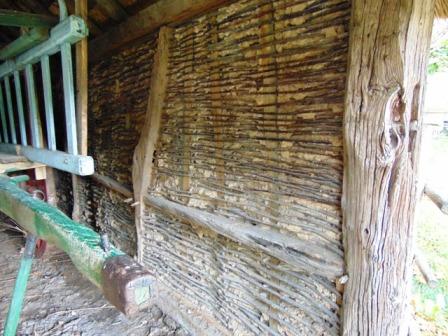People first will have helped themselves with caves and holes, or trees as rain and wind screens. In some prehistoric caves are remnants of windshields found: dry stone walls at the entrance. The first steps towards building an own nest.
 Walls making happens anywhere with the available material that can be found in the area. Usually by piling it.
Walls making happens anywhere with the available material that can be found in the area. Usually by piling it.
Ice blocks can form igloos.
Sods and stones are stacked to walls.
Also (mammoth) bones are stacked to dwellings.
Today there are still built adobes of ground. Variants muffle the ground first in (long and narrow) bags. Or in old car tires.
To make a Log Cabin windproof crevices were caulked (like ships) and chinked. Larger openings are densely crammed with dry material such as straw or moss. Filling joints happens with loam or clay, sometimes mixed with chopped dry materials or sawdust. To 2 parts of clay (soil with + 30% of clay) was in the United States often one part of sieved wood ash, and 1.2 part salt added. And sufficient water to make it kneadable and spreadable.
If the stones are knocked in fitting shapes they stack firmer. Pyramids and temples survived centuries. Even into rocks or underground enclosures were carved.
With a binder such as mortar or concrete, we still can admire Roman aqueducts and theaters centuries later.
More perishable reeds and twigs were used to braid walls.
And woven cloths or skins to set temporary or permanent tents.
In timber framing all edges and openings are made of solid oak. Then people started making bricks and use them later but didn’t found that sufficiently reliable. Often justified by the unstable firing of bricks. The to soft stones crumbled and pulverized often. Therefore, the timber was often imitated in stone. In old houses, castles and farms you still see that the pillars, windows and doors are of stone, and the boxes in between are filled with bricks.
